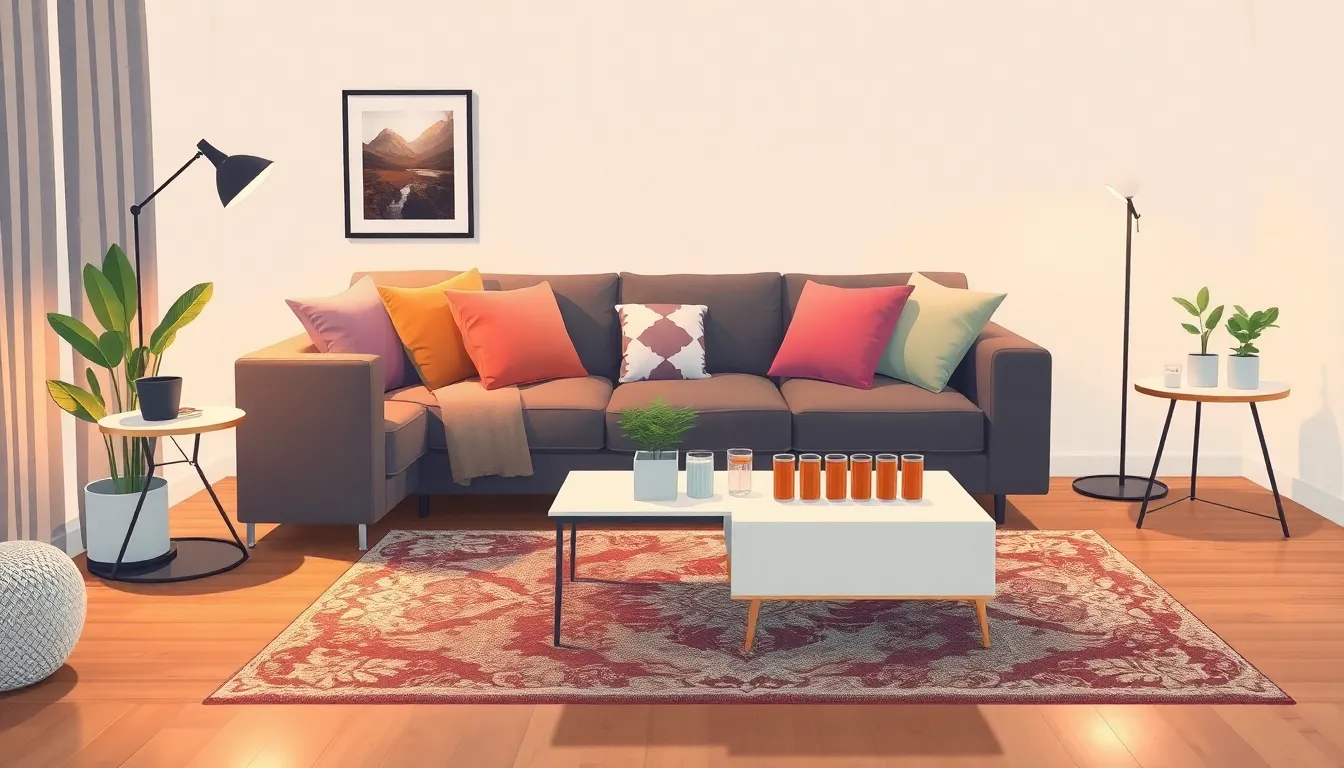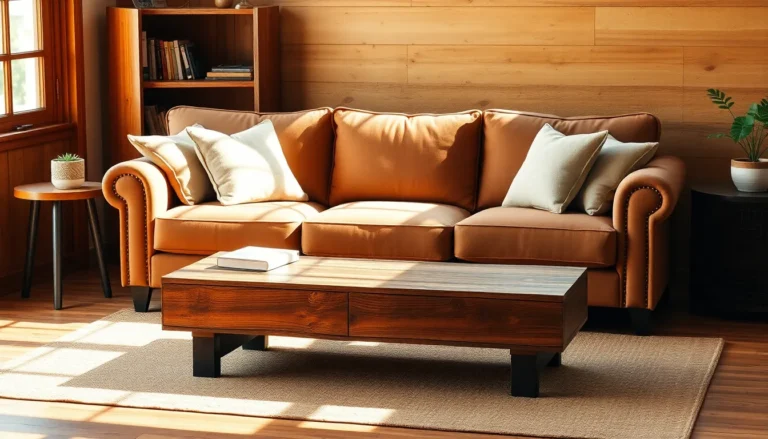Table of Contents
ToggleWhen it comes to room furniture, it’s more than just stuff to sit on or place your snacks. It’s the unsung hero of your space, transforming a dull room into a cozy haven or a stylish sanctuary. Picture this: a comfy sofa that whispers sweet nothings to your back after a long day, or a coffee table that doubles as a makeshift dining spot during movie marathons.
Understanding What A Room Furniture Is
Room furniture encompasses various items designed to enhance living spaces. These pieces serve functional purposes while contributing to the room’s overall aesthetic. Sofas and chairs provide comfort for seating, while tables offer surfaces for dining or displaying decor. Each item fulfills specific needs, such as storage or relaxation.
Types of room furniture include essential categories like seating, tables, storage, and accessories. Seating options range from sofas and armchairs to benches, accommodating different styles and preferences. Tables vary from dining to coffee tables, all designed to meet specific activities. Storage solutions include cabinets, shelves, and dressers, catering to organization and privacy.
Design styles in room furniture create unique atmospheres. Modern furniture often features clean lines and minimalistic designs, promoting simplicity. Conversely, traditional styles incorporate ornate details and rich materials, evoking a classic feel. Each design type influences the space’s mood and functionality.
Quality materials determine durability and appearance. Wood, metal, and upholstery fabrics play crucial roles in the overall look and longevity of furniture. Solid wood pieces often provide sturdiness, while metal elements contribute a sleek industrial vibe. Upholstered items enhance comfort through various fabric choices.
Room furniture fosters versatility in any living space. Multi-functional pieces, such as sleeper sofas or extendable dining tables, adapt to changing needs. Styles and functionality combine, allowing individuals to personalize their environments based on lifestyle and preferences.
Choosing the right furniture ensures maximum enjoyment and utility. Factors such as space size, design preferences, and budget impact decisions. Understanding room furniture leads to intentional selections that complement and elevate every room.
Types Of Room Furniture

Various types of room furniture cater to different living spaces and needs. Understanding each category helps in making informed choices that complement functionality and style.
Living Room Furniture
Living room furniture includes sofas, armchairs, and coffee tables. Sofas provide comfort and seating for guests, while armchairs offer additional relaxing spots. Coffee tables serve as focal points for gatherings, providing space for drinks, snacks, and decor. Entertainment units or TV stands often organize media devices, enhancing the viewing experience. Additionally, accent chairs and side tables contribute to the overall aesthetic and usability of the space.
Bedroom Furniture
Bedroom furniture typically consists of beds, nightstands, dressers, and wardrobes. Beds create a restful environment, with sizes like twin, full, queen, and king catering to various needs. Nightstands provide convenient spots for lamps, alarms, and personal items. Dressers and wardrobes help in organizing clothes and accessories, maintaining a clutter-free atmosphere. Additionally, benches or ottomans at the foot of the bed offer both style and extra storage.
Dining Room Furniture
Dining room furniture comprises dining tables, chairs, and sideboards. Dining tables serve as central pieces for meals and gatherings, available in various shapes such as round, square, or rectangular. Chairs complement the table, ensuring comfort for diners. Sideboards or buffets provide storage for dinnerware and serve as surfaces for food presentation during hosting. This combination defines the dining area, merging functionality with elegance.
Office Furniture
Office furniture includes desks, chairs, and storage units. Desks provide essential workspaces, with styles ranging from traditional to contemporary for various preferences. Ergonomic chairs enhance comfort during long hours spent working. Bookcases and filing cabinets organize documents and supplies, contributing to a tidy environment. Coffee tables and lounge chairs may also enhance office areas, promoting a relaxed yet professional atmosphere.
Key Considerations When Choosing Room Furniture
Selecting room furniture requires careful thought about several essential factors. The right choices enhance both the aesthetics and utility of a space.
Style And Design
Each room’s ambiance relies heavily on its style and design. Choosing contemporary or traditional pieces shapes the overall atmosphere significantly. Popular design themes such as minimalist, rustic, or industrial profoundly influence aesthetic appeal. Mixing styles can add character but demands a keen eye for balance. Unique accents, such as bold colors or intricate details, provide focal points that draw attention. Prioritizing design elements that reflect personal taste ensures the room feels inviting and cohesive.
Material And Durability
Choosing the right materials directly impacts both appearance and longevity. Solid wood remains a top choice for its durability and timeless elegance. Metal and glass offer sleek, modern options, while upholstery fabrics can enhance comfort significantly. The quality of materials affects maintenance and visual appeal over time. Selecting furniture made from sustainable materials aligns with eco-friendly values and ensures durability against wear and tear. Reliable construction methods, such as joints and finishes, play a crucial role in maintaining structural integrity.
Comfort And Functionality
Comfort ranks high among furniture choices as it influences daily experiences. Prioritizing ergonomic designs promotes physical well-being, especially for seating options. Multi-functional furniture serves great utility, particularly in smaller spaces. Sofas that convert to beds or tables with storage options save space while remaining stylish. Assessing personal routines helps identify essential features that cater to specific needs. Incorporating elements that enhance comfort and usability creates a harmonious living environment.
Tips For Arranging Room Furniture
Consider functionality first when arranging room furniture. Prioritize accessibility by ensuring pathways are clear and easy to navigate. Avoid clutter by placing larger furniture pieces against walls, creating open spaces in the center of the room.
Utilize rugs to define different areas within open-concept spaces. Define the living area with a rug beneath the sofa and coffee table to establish a cozy atmosphere. Group seating arrangements to facilitate conversation, positioning chairs and sofas close together to encourage interaction.
Assess light sources while arranging furniture. Natural light enhances mood, so position seating near windows for a brighter environment. Use lamps to create warm, inviting corners in darker areas, ensuring all zones receive adequate illumination.
Incorporate storage solutions to maintain organization. Select furniture with built-in storage, such as ottomans or coffee tables with drawers. This tactic reduces visual clutter, maximizing utility while preserving aesthetics.
Experiment with various layouts before finalizing arrangements. Make use of painter’s tape to outline furniture dimensions on the floor, allowing for a better visual representation. Evaluate each configuration for comfort and functionality, making adjustments as necessary.
Incorporate decorative accessories to enhance visual interest. Choose items such as artwork or plants that complement the furniture style, adding personality to the space. Balance these accents throughout the room to create a cohesive look.
Finally, personalize arrangements according to individual preferences and routines. Consider how the room’s design supports daily activities, promoting an enjoyable and purposeful living environment. This tailored approach fosters a harmonious balance between style and practicality.
Choosing the right room furniture plays a crucial role in creating a welcoming and functional living space. Each piece not only serves a purpose but also contributes to the overall aesthetic and comfort of the room. By understanding the various types of furniture and their specific functions, individuals can make informed decisions that align with their personal style and needs.
Investing in quality materials ensures durability and enhances the visual appeal of any space. Thoughtful arrangement further maximizes utility while maintaining a stylish environment. Ultimately, the right furniture can transform any room into a cozy sanctuary that reflects individual preferences and lifestyles.





